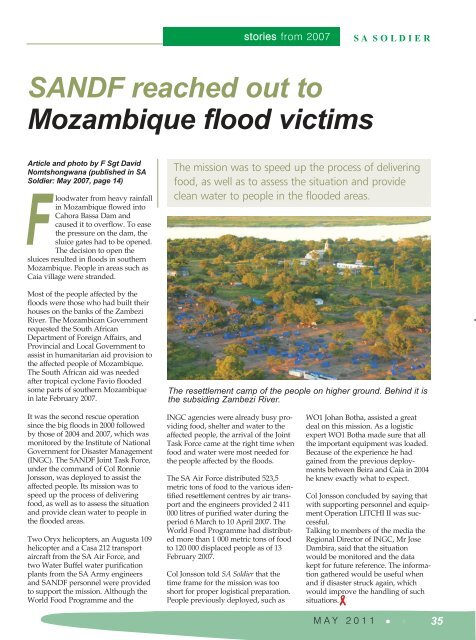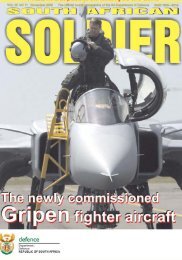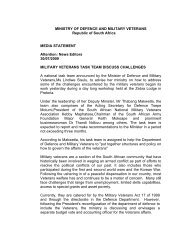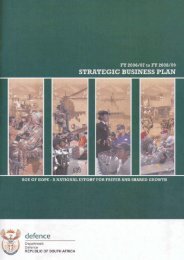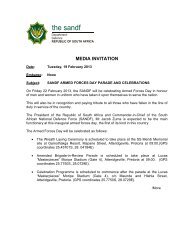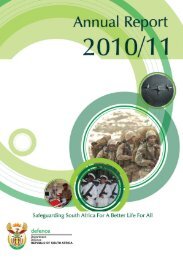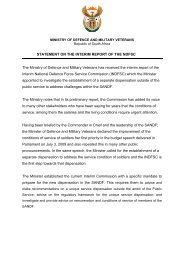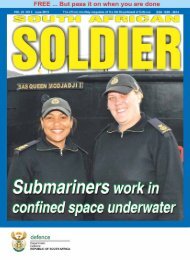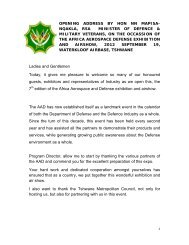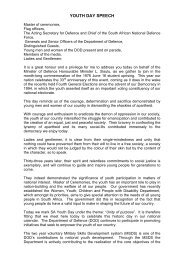letters to the editor - Department of Defence
letters to the editor - Department of Defence
letters to the editor - Department of Defence
You also want an ePaper? Increase the reach of your titles
YUMPU automatically turns print PDFs into web optimized ePapers that Google loves.
s<strong>to</strong>ries from 2007S A S O L D I E RSANDF reached out <strong>to</strong>Mozambique flood victimsArticle and pho<strong>to</strong> by F Sgt DavidNomtshongwana (published in SASoldier: May 2007, page 14)Floodwater from heavy rainfallin Mozambique flowed in<strong>to</strong>Cahora Bassa Dam andcaused it <strong>to</strong> overflow. To ease<strong>the</strong> pressure on <strong>the</strong> dam, <strong>the</strong>sluice gates had <strong>to</strong> be opened.The decision <strong>to</strong> open <strong>the</strong>sluices resulted in floods in sou<strong>the</strong>rnMozambique. People in areas such asCaia village were stranded.Most <strong>of</strong> <strong>the</strong> people affected by <strong>the</strong>floods were those who had built <strong>the</strong>irhouses on <strong>the</strong> banks <strong>of</strong> <strong>the</strong> ZambeziRiver. The Mozambican Governmentrequested <strong>the</strong> South African<strong>Department</strong> <strong>of</strong> Foreign Affairs, andProvincial and Local Government <strong>to</strong>assist in humanitarian aid provision <strong>to</strong><strong>the</strong> affected people <strong>of</strong> Mozambique.The South African aid was neededafter tropical cyclone Favio floodedsome parts <strong>of</strong> sou<strong>the</strong>rn Mozambiquein late February 2007.The mission was <strong>to</strong> speed up <strong>the</strong> process <strong>of</strong> deliveringfood, as well as <strong>to</strong> assess <strong>the</strong> situation and provideclean water <strong>to</strong> people in <strong>the</strong> flooded areas.The resettlement camp <strong>of</strong> <strong>the</strong> people on higher ground. Behind it is<strong>the</strong> subsiding Zambezi River.It was <strong>the</strong> second rescue operationsince <strong>the</strong> big floods in 2000 followedby those <strong>of</strong> 2004 and 2007, which wasmoni<strong>to</strong>red by <strong>the</strong> Institute <strong>of</strong> NationalGovernment for Disaster Management(INGC). The SANDF Joint Task Force,under <strong>the</strong> command <strong>of</strong> Col RonnieJonsson, was deployed <strong>to</strong> assist <strong>the</strong>affected people. Its mission was <strong>to</strong>speed up <strong>the</strong> process <strong>of</strong> deliveringfood, as well as <strong>to</strong> assess <strong>the</strong> situationand provide clean water <strong>to</strong> people in<strong>the</strong> flooded areas.Two Oryx helicopters, an Augusta 109helicopter and a Casa 212 transportaircraft from <strong>the</strong> SA Air Force, andtwo Water Buffel water purificationplants from <strong>the</strong> SA Army engineersand SANDF personnel were provided<strong>to</strong> support <strong>the</strong> mission. Although <strong>the</strong>World Food Programme and <strong>the</strong>INGC agencies were already busy providingfood, shelter and water <strong>to</strong> <strong>the</strong>affected people, <strong>the</strong> arrival <strong>of</strong> <strong>the</strong> JointTask Force came at <strong>the</strong> right time whenfood and water were most needed for<strong>the</strong> people affected by <strong>the</strong> floods.The SA Air Force distributed 523,5metric <strong>to</strong>ns <strong>of</strong> food <strong>to</strong> <strong>the</strong> various identifiedresettlement centres by air transportand <strong>the</strong> engineers provided 2 411000 litres <strong>of</strong> purified water during <strong>the</strong>period 6 March <strong>to</strong> 10 April 2007. TheWorld Food Programme had distributedmore than 1 000 metric <strong>to</strong>ns <strong>of</strong> food<strong>to</strong> 120 000 displaced people as <strong>of</strong> 13February 2007.Col Jonsson <strong>to</strong>ld SA Soldier that <strong>the</strong>time frame for <strong>the</strong> mission was <strong>to</strong>oshort for proper logistical preparation.People previously deployed, such asWO1 Johan Botha, assisted a greatdeal on this mission. As a logisticexpert WO1 Botha made sure that all<strong>the</strong> important equipment was loaded.Because <strong>of</strong> <strong>the</strong> experience he hadgained from <strong>the</strong> previous deploymentsbetween Beira and Caia in 2004he knew exactly what <strong>to</strong> expect.Col Jonsson concluded by saying thatwith supporting personnel and equipmentOperation LITCHI II was successful.Talking <strong>to</strong> members <strong>of</strong> <strong>the</strong> media <strong>the</strong>Regional Direc<strong>to</strong>r <strong>of</strong> INGC, Mr JoseDambira, said that <strong>the</strong> situationwould be moni<strong>to</strong>red and <strong>the</strong> datakept for future reference. The informationga<strong>the</strong>red would be useful whenand if disaster struck again, whichwould improve <strong>the</strong> handling <strong>of</strong> suchsituations.M A Y 2 0 1 1 • s 35


